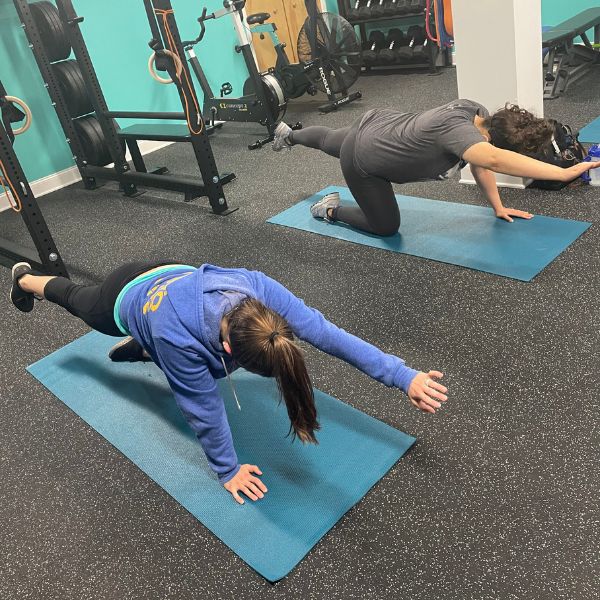There are a large number of exercises for your early postpartum period that you can do safely to help with recovery, rehabilitation, strength and stress relief! Although you are not typically cleared for exercise until your 6 week postpartum appointment, this does not mean that you have to be sedentary for 6 weeks.
Diaphragmatic Breathing
You may not be familiar with this type of breathing. It has also be referred to as a belly breath, a 360 degree breath or a full core breath. Most people breathe into their chest using secondary muscles of inspiration instead of using their diaphragm to full capacity. The diaphragm and the pelvic floor act as a piston system. As you inhale the diaphragm will lower to make room in your lungs for air. As your diaphragm lowers you pelvic floor will do the same. When you exhale, both will return to their starting positions. Spending 5 minutes per day lying on your back with your knees bent and feet flat on the floor helps regulate your nervous system and calm the brain. Feel free to even do this numerous times per day with your baby on your chest.
Transverse Abdominis (TA) Activation
The TA is a deep core muscle that resembles a corset in the abdomen. It is an important muscle for early postpartum core stability. When performing this movement you always want to begin with a deep full core breath and as you exhale think about hugging a baby in your belly or zipping up a high waisted pair of shorts. This visualization will help you create tension in your core. You want to make sure that you are not sucking in, as abdominal hollowing does not create stability in the core. When performing this movement you may feel a slight pelvic floor lift – that is OK, but I do not want you doing a kegel with this movement. Begin performing 2 sets of 10 once per day following your 5 minutes of diaphragmatic breathing.
Box Squat
Squats are literally essential to life. We are moving from sitting to standing numerous times per day and I believe that we should be able to do it safely, especially when you may be holding a newborn. Squatting is SAFE postpartum, is SAFE for your knees and is GOOD for you! Especially when loaded, think about hugging a baby in your belly before pushing through the ground to come to standing while making sure that your knees are always tracking over the toes. You do not want your knees to buckle towards each other. Feel free to perform sets of 15-20 numerous times per day, whether loaded or with just your body weight! C
Functional Progression 3
I love this movement because it is so easy to modify up and down based on where you are in your journey. It may look similar to a bird dog, but the intention behind the movement is so much deeper. This movement is meant to be done slow so that it promotes core stability and strength. Begin by moving just your arms, moving just your legs or by moving the opposite arm and leg. Make sure that your hips are not swaying side to side as you move, so really focus on keeping your torso still as you move through the reps. Doing 2 sets of 10/side daily is a great place to begin. You can even have your newborn on the floor right under you to bond with them while you move.
Function Progression 4
This movement is amazing for full body strength. It absolutely strengthens the core, but also the entire body! Once again, this movement is meant to be done intentionally and should not look like a downward facing dog. The hips should move up and back while the knees come off the floor. The spine should stay neutral throughout. Take two diaphragmatic breaths at the top of the movement with each rep. Perform 10-12 of these daily.
This is just a small snapshot of where your postpartum recovery and rehabilitation can begin. Myself and Dr. Caitlin Simpson together hold a Postpartum Recovery Series every couple of months that has helped many women get stronger and return to exercise safely. For more information on the series, CLICK HERE.





